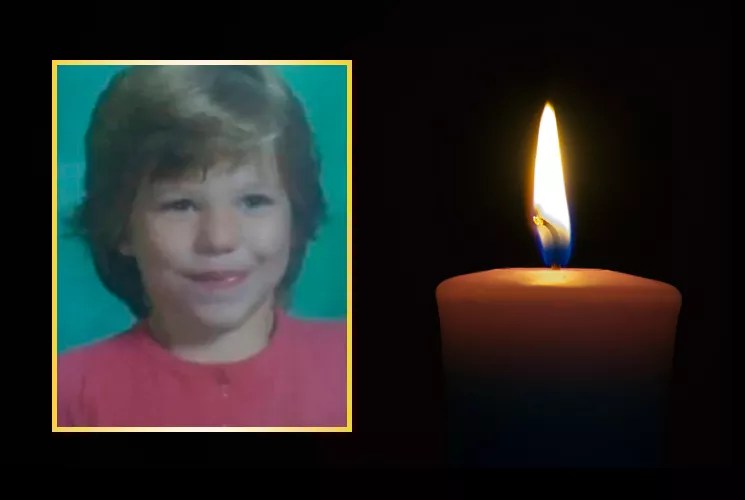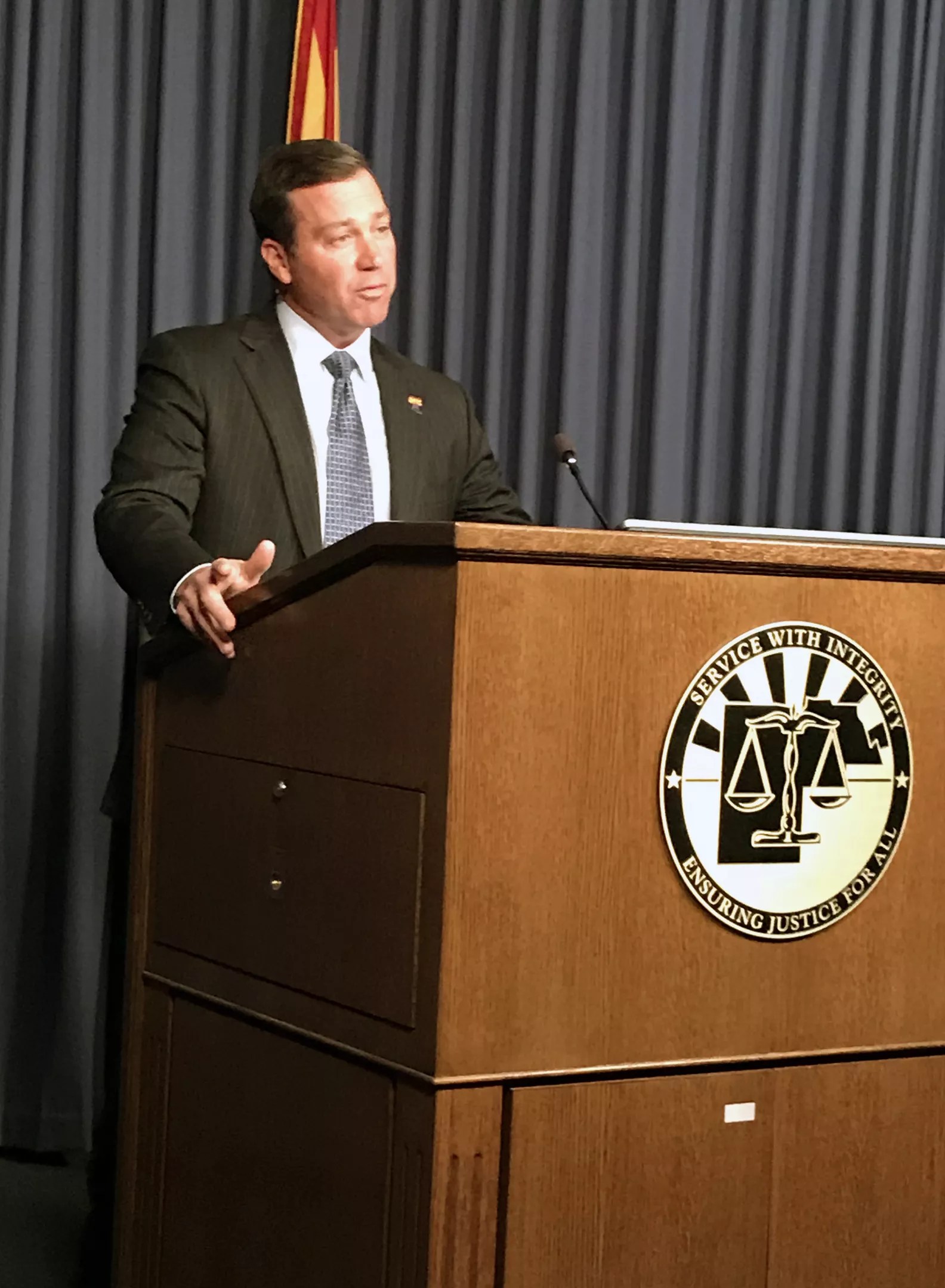
New Times photo illustration

Audio By Carbonatix

New Times photo illustration
Ame Deal has been dead for more than six years now. In that time, all of her tormentors and killers have gone to prison and the agency that was supposed to protect vulnerable children like her has been overhauled.
On Tuesday, Arizona Department of Child Safety Director Greg McKay briefed reporters on the progress made since the agency was reformed. Caseloads are down, backlogs all but gone, public tips at record levels, and foster care adoptions on the rise.
But McKay and Maricopa County Attorney Bill Montgomery were quick to point out theirs was not a victory lap.
And the tough questions they had to answer about the death of another child in Maricopa County, 7-year-old Sanaa Cunningham of Goodyear, emphasized that point.
This year, make your gift count –
Invest in local news that matters.
Our work is funded by readers like you who make voluntary gifts because they value our work and want to see it continue. Make a contribution today to help us reach our $30,000 goal!
They acknowledged that the conditions that led to Phoenix police finding Ame Deal dead inside a plastic storage box, marinated in her own sweat and urine, exist unchanged today.
Child welfare investigators in Midland, Texas, and Ogden, Utah, knew Ame had been brutalized before her big extended family relocated to south Phoenix. Child welfare agents here had no clue.
No repository exists for states to share child abuse information. Child abuse investigators only learn of out-of-state cases after the fact. After it’s too late. After, as in Ame’s case, the children are dead.
“There is no national database or repository of information that tracks children who have been abused in other states,” McKay said. “So when they come into our communities, there is no way of knowing where they were and what was their experience.”
Montgomery said the issue came up when he chaired a state task force in 2011 to reform the state’s child protection system. It was one of the holes.
“That’s one area where our child welfare system … could certainly improve,” Montgomery said.
McKay was the Phoenix homicide detective who led the investigation into Ame’s death. He noted there had been earlier cases like it where families abused children in other states before murdering them in Phoenix.
“I would absolutely love to see a central system in the United States of America that tracks children with substantiated cases of abuse,” McKay said. “It is puzzling to me that we can’t put something together like this.”
With 50 states and more than 3,000 counties in the country, each with its own procedures for collecting and sharing information, as well as investigating child abuse cases, the hurdles are high.

Arizona Department of Child Safety Director Greg McKay
Sean Holstege
Even without sharing, some states are turning to technology. Focusing on key indicators of severe abuse, such as food deprivation, confinement, and forced isolation, some child welfare agencies are using predictive analytics to identify families most likely to commit child abuse murder.
California is working on a system it hopes to roll out in early 2019, according to the Los Angeles Daily News. Los Angeles County began exploring a similar idea in 2016.
Illinois experimented with predictive analysis until a Chicago Tribune investigation showed the software to be unreliable.
Had a national database existed in 2011 before Ame was stuffed and padlocked into a lockbox in the height of summer, Arizona authorities would have known what McKay later found out about the lifelong scope of her torment.
“Ame Deal was destroyed over a seven-year period in three states, and none of us here knew about it.”
In Midland she “was condemned to live in a dog crate, and when authorities caught on, they moved,” McKay said.
“She was beaten, neglected and humiliated in Ogden,” he added, noting that there she went to school smelling of feces and urine, with lice in her hair and cockroaches in her clothes. Teachers chipped in to get her some glasses, which her family destroyed within a day.
“When authorities became more assertive in Utah, they moved,” McKay said.
In Phoenix, she was forced to sleep on the shower floor. She was pulled up by her hair, beaten, and shoved in frigid water in the middle of the night. The family forced her to eat dog feces when she missed a spot in her chores to clean up the yard.
“As the homicide detective who investigated Ame’s life and death, I was faced with this immensely sad revelation that the best moment of Ame Deal’s life was the moment of her death.” McKay said.
For those crimes, her cousin Sammantha Allen and her husband, John Allen, were sent to death row, the only couple in Arizona ever to face the death penalty. Three other family members got between 10 and 24 years in prison.
Ame Deal was not on the state’s radar before she died.
But other kids had been.
Much of the outrage over the agency, then called Child Protective Services, centered on children who died even after case agents had investigated non-fatal abuse in their homes.
When McKay discovered that the agency had ignored 6,000 abuse investigations, the outrage grew.
And despite progress, problems have not vanished.
On Monday, DCS published a required online report summarizing the death of 7-year-old Sanaa Cunningham of Goodyear.
In the report, the state accused her parents, 42-year-old Lisa Cunningham, and 37-year-old father and former Phoenix cop, Germayne Cunningham.
DCS said she died of complications from sepsis, but suffered from acute bronchitis and pneumonia, and had numerous abscesses and ulcers on her skin.
On December 1, a Maricopa County grand jury handed up an 11-count indictment, accusing the couple of first-degree murder and child abuse, beginning as early as June 2016.
Details of the alleged crime remain sealed, per a court order.
That year, state child welfare agents had visited the home in March in response to a neglect complaint, and again in October to investigate a sex abuse allegation. The state deemed both cases unsubstantiated and closed.
In December 2016, agents returned to investigate allegations of physical abuse and neglect of Sanaa. The case was still pending when the girl died on Feb. 12.
Tuesday’s press conference prompted a barrage of questions about:
• The timing of the death, two months after a case was opened.
• The 10-month delay in reporting it.
• The two-week lag between the indictment and the report.
• The maintained secrecy of a routine jail booking sheet.
McKay explained death investigations take time; while Montgomery said he decided to keep the records sealed to protect the investigation.
The pair patted themselves on the back for going forward with their announcement despite the nature of the Sanaa Cunningham case.
“The bunker culture is gone. We don’t play hide the ball anymore,” McKay told a roomful of skeptical reporters.
The press conference underscored their point that while progress has been made in the last six years, much remains to be done.
Still, progress has been made.
Before Ame Deal’s death, people who called to report abuse on the emergency hotline would often wait hours for somebody to answer. A third of them hung up in disgust. Today, the average wait time is 28 seconds and only 2 percent of callers think twice.
Then, only 54 percent of cases involved teams of cops and welfare investigators. Today it’s closer to 95 percent.
Then, the backlog of unresolved child abuse investigations was 16,200 cases. Today it’s 280.
Caseworkers often faced caseloads of 150 or more. Today, according to DCS’s most recent quarterly report, caseloads range from eight to 17 in Maricopa County.
When Ame died, Arizona ranked dead last among states for the volume of unplaced foster kids, which topped 19,000. The volume grew 92 percent in 10 years, the fastest in the country. Today, McKay said, it was best in the country for lowering the backlog of foster placements, while the rest of the country’s backlog grew 4 percent.
It took the discovery of Ame Deal’s misshapen, discolored body next to the box that was her prison and tomb before real reform could happen.
“I am able to gather some small degree, a very small degree, of consolation that her death was not in vain and served as a catalyst for change,” Montgomery said.
“I am incredibly honored to remember Ame and to haves suffered secondarily from her sad life,” McKay said. “Without shared suffering, the will to fight for the weak and vulnerable grow pale.”